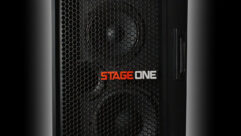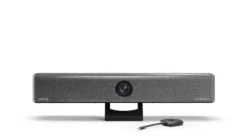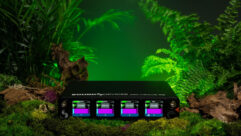A Decade of Change for LCD TechnologyA decade ago, we thought wireless slide controllers were the state of the art. Now we have multimedia touchscreens capable of video display, computer display and control.
May 20, 1996 12:00 PM,
Daniel S. Kippycash
It was early morning as I stood nervously behind the podium waiting to begin my presentation. As I looked down at the technology available to me, I felt confident I could control this important presentation. The one area technology couldn’t help was my assurance the presentation would be well received.
Mounted within the podium was a computer monitor, small video monitor and a Star-Wars-looking touch-screen control panel. This was an incredible leap in technology for me. In the past it was standard practice to use color overhead transparencies or, for a really impressive presentation, a slide show with dual slide projectors and a dissolve unit. If I really wanted to impress, maybe I would include a wireless slide controller. Although that might seem like the ice age, this technology was leading-edge as recently as the mid 1980s.
The future is nowToday’s control systems from industry leaders such as AMX and Crestron provide increased control capabilities and several choices in touchscreen technology. For several years, choices in LCD touchscreen technology were limited: electroluminescent (black and amber) or DST (black on white). It wasn’t until three years ago that manufacturers introduced an active matrix color display touchscreen that also provided direct display of video images. In 1996, technology continues to expand control-system capabilities and user-interface choices.
The increased production at several LCD display manufacturers, such as Sharp, Philips and NEC, has continued to bring the cost of LCD technology to more affordable levels. The choices in LCD touchscreen technology currently available include many options:
DST (double super twist) black on white.Wireless grayscale LCD displays.Grayscale LCD displays.Wireless passive matrix displays.Passive matrix color.Active matrix color.Active matrix color with video.Active matrix color with video and data display.The expanded role of LCD touchscreen technology within control systems in the audio-visual industry has assisted in the interface of people with technology. Systems by AMX and Crestron are being designed to operate everything from corporate boardrooms and major arenas to theme park attractions and home theaters. With the continuing evolution of computer-generated presentations, teleconferencing and projection display can be designed to become one system, all controlled by an LCD touchscreen.
In the beginning …The use of LCD touchscreens began to appear in corporate boardroom installations in the early 1980s. The screens provided user control of multiple subsystems from one easy-to-use, custom touchscreen.
The ability to custom tailor each screen, complete with custom macros allowing execution of multiple functions via a single touch, has continued to command great attention. As boardroom requirements and capabilities expand, the use of LCD touchscreens has gained tremendous attention.
The ability of an integrator or consultant to offer the client a solution to the sometimes confusing world of control brings value to each project. Systems offered by AMX and Crestron are fully software configurable. Both companies provide extensive training to their dealer bases, which expands their ability to program these systems in house and make changes on site. The increased use of teleconferencing has continued to create a need for expanded control. Although most teleconferencing systems available today provide comprehensive control stations as standard equipment with their systems, they typically only allow control of that specified system. The implementation of a control system with an LCD touchscreen can enhance not only the system capabilities but the ease of use.
Interfacing with new technologySystems such as the Crown IQ and Peavey Media Matrix and offerings from IED, Oxmoor, IRP and TOA have become standard specifications in many arenas and parks. Most projects of this size and nature require control of multiple zones of audio, ambient sensing and paging. With the use of a single LCD touchscreen, complete control of these systems is only a touch away.
Imagine the newest stadium and the multiple seating levels they provide. The use of a touchscreen can provide control of each section, even to match the stadium section color. Imagine as the home team drives toward the end zone, an operator could simply press the Red and Blue section of the stadium layout displayed on the touchscreen to increase the levels of all background music or announcements for these sections only.
LCD meets multimediaAs the use of LCD technology has continued to gain acceptance throughout the entire audio-visual community, it has become more than simply an A-V control device. The ability to work in the multimedia realm has become popular. Today, it’s rare to see a presentation without the use of a dedicated computer or laptop. Today’s control systems offer an incredible selection of LCD touchscreen technology to best fit each application. Touchscreens that offer color video display, data display and total system control all displayed on a single touchscreen have received world-wide attention.
Using an existing computer as a control screen is a readily available option. AMX and Crestron offer software that can be loaded on a computer or laptop, which in turn can communicate with each of the manufacturers’ control systems. This provides the design flexibility of using a preexisting computer or a new one specified to become the control screen. This computer can then be controlled via a mouse by a touchscreen CRT monitor.
These innovations provide multimedia solutions, not just ease of operation. By combining display and control technologies, such systems save space and reduce cabinet costs. For example, if a sophisticated system has been specified to provide the presenter with a podium-mounted data monitor, a 5 to 6 inch (127 mm to 152 mm) video monitor and an LCD touchscreen, the solution can combine all three multimedia formats into one LCD touch-screen. This solution provides a much smoother user interface, and it has the potential to save the project money. When you compare the price of today’s multimedia LCD touchscreen technology, which starts at less than $7,000, with the combined cost of individual hardware, increased podium size and necessary labor, the cost analysis becomes quite interesting.
Market growthWith continuous product innovations, AMX and Crestron continue to receive tremendous attention during industry trade shows. Considering the presence of industry giants such as Sony, Barco, Sharp and Hughes, to name a few, it seems the increased focus on LCD touchscreen control systems continues to grow.
During the 1995 ICIA Infocomm Show in Dallas, Crestron was named manufacturer of the year for its Visiontouch multimedia touchscreen. The Visiontouch provides active matrix color display control, real-time video display and multi-sync computer display.
The ability to specify control panels with color display adds a whole new dimension to control system technology. In the past, LCD touchscreen panels could only provide two color options: black and white for the DST type of panel and black and amber for the electroluminescent panel. The introduction of the color LCD touchscreen was an immediate success, largely because the price for the color LCD was the same as for the electroluminescent LCD.
The introduction of color LCD technology has increased flexibility of design. For example, if a user is operating a VCR, his comfort level increases when colors represent device action, such as having play turn green or stop turn red when activated. Color LCD touchscreens can also import color photos, company logos and icons. This helps create a user interface with pictures of the devices to be controlled.
As remarkable as LCD touchscreen control system can be, it’s the continued expansion of production by the LCD manufacturers that has brought the technology price points down and will continue to help expand the use and markets for control systems. This trend cannot be more evident than the residential custom installations market.
At the 1995 CEDIA Expo, more than six manufacturers were showing LCD touchscreen technology. The availability of portable LCD touchscreens and compact units with screen sizes of 5 inches (127 mm) to 6 inches (152 mm) diagonal have opened many opportunities in the residential custom installation market. Now consumers can have the same options at home that are available to them at the office.
What does the future hold?As technology continues to forge ahead, only the creative engineers who have brought the industry the innovative products we currently use can describe the next technological breakthrough.
This brings the important fact of communications to mind. As manufacturers we welcome comments and suggestions from those who use and install systems such as these. If you’re working on a particular system specification and wonder, “Can this be done?” more often than not your control manufacturer can help answer that question.










